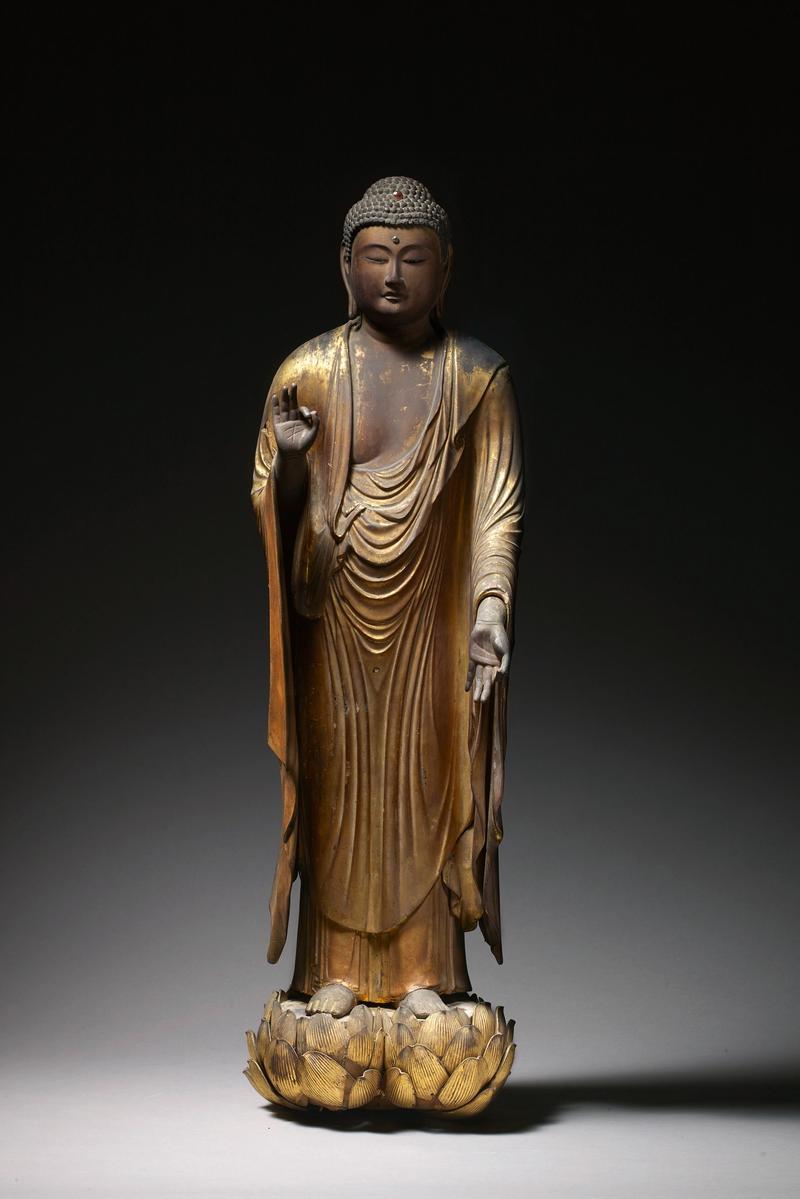A carved wood figure of standing Daiarakan (Sacred Arhat) with gyokugan (inlaid crystal eyes).
Japan, 12th/13th century, Kamakura period.
An old fitted wood box inscribed:
Lid: Daiarakan sonzo (A sacred sculpture of Arhat) with two seals Kei and Do
Lid inside: Ishikawa Shuntai ro-taishi hakogaki, Keido shiki (The box inscription by the old respected monk Ishikawa Shuntai, attestation by Keido) with two seals
External box: Daiarakan sonzo, hakogaki Ishikawa Setsudo roshi dai (A sacred sculpture of Arhat, the title inscription on the box written by the respected monk Ishikawa Setsudo)
Provenance: Collection of Ishikawa Shuntai (1842-1931)
Arakan or rakan (arhats) are Buddhist disciples who have conquered all passions and are liberated from the burden of rebirth. They are said to have originally numbered five hundred but in various types of Japanese artistic representations a smaller group of sixteen rakan is the focus. Following Chinese tradition each member of this group is individually named and associated with a particular attribute such as a fly whisk, a gong, a scroll, a palm-leaf book or a dragon. Rakan are usually depicted with shaved heads, long earlobes and unadorned draped robes, sometimes leaving one shoulder bare. Daiarakan refers to the most respected rakan.
Ishikawa Shuntai (1842-1931) was a priest of Otani-ha sect of Jodo-shinshu Buddhism. In 1878 he became the secretary general of the Higashi Honganji, the main headquarters of Otani-ha, and was influential in the modernisation of the sect. Priest name: Keiho, Setsudo, Sekijo, Ryuen.
For the figures of ten principal disciples by Kaikei see Nara National Museum ed., The Buddhist Master Sculptor Kaikei: Timeless Beauty from the Kamakura Period, (Nara, 2017), p. 158-9 (early 13th century, Important Cultural Property, Daihoon-ji Temple, Kyoto).
For the comparable figures of ten principal disciples dated 1268 see Tokyo National Museum ed., Special Exhibition: Japanese Sculpture of the Kamakura Period, (Tokyo, 1975), no. 88 (Gokurakuji temple, Kanagawa, Important Cultural Property).
Radio Carbon Dating Ref: RCD-9282
Buddhist Art

A kakemono with the monk Hōnen

A kakebotoke

Zenkoji Kannon Bosatsu

Buddhist wood panels

A wood figure of Amida Nyorai, Heian/Kamakura period

Kakebotoke of Bishamonten

Dainichi Nyorai

Amida Buddha

Daiarakan (Sacred Arhat)

Jizō Bosatsu

Amida Buddha

A silk kakemono with Kannon

An iron nyoi

Zushi with Kannon

A bronze kakebotoke of Kannon

A lacquer and gilt wood figure of a seated Amida Nyorai (Amitābha) dressed in a flowing robe













